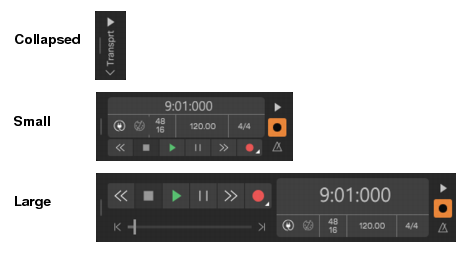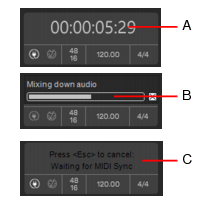Figure 259. Transport module sizes.Right-click the Control Bar and select Modules > Transport.Figure 260. The Transport module.A. Rewind B. Stop C. Play D. Pause E. Fast Forward F. Record G. Dropout indicator H. Current Now time (this space is also used for progress bars and “Waiting for sync” messages) I. Go to Start (RTZ) J. Position K. Jump to project end L. Audio Engine on/off M. Reset/Panic N. Sample rate and bit depth O. Tempo P. Meter Q. Metronome during record R. Metronome during playback S. Click to open metronome settings






. Start recording (requires at least one track to be armed for recording). Right-click to access global record options. Click and keep the mouse button pressed for a brief moment to choose the desired record mode and how new Take lanes are created during recording. For details, see Recording modes.

















. Appears whenever the audio engine is stopped as a result of a dropout. For details, see Dropouts and other audio problems.

. Enable/disable the audio engine. The Audio Engine button lights up if the audio engine stops running. To restart the audio engine, click the Audio Engine button.

. Reset any stuck MIDI notes. The Reset button flashes if a MIDI note is stuck. To force a restart of the audio and MIDI engine (only if the transport is not playing/recording), including a reset of ASIO, hold down the CTRL key and click the Reset button. The Reset button sends both controller 123 and individual note off messages to soft synths. For hardware MIDI outs, if necessary you can use the PanicStrength Cakewalk.ini variable to specify the default behavior:




. Enable/disable the metronome during recording. Right-click to access Metronome settings.

. Enable/disable the metronome during playback. Right-click to access Metronome settings.

Tip - Searching Documentation
Tip: To search for a specific topic, type your search query in the Search Cakewalk.com field at the top right of this page.
When the search results appear, click which product's documentation you would like to search to filter the search results further.
Note - Using Offline Help
Note: If you prefer to always use offline Help, go to Edit > Preferences > File > Advanced in your Cakewalk software and select Always Use Offline Help.
If you are not connected to the internet, your Cakewalk software will default to showing offline help until an internet connection becomes available.






